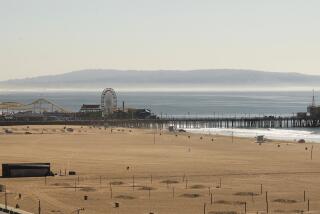The Beach: For Surf City, It’s a Capital Idea
The Huntington Beach events calendar reads like a city booster’s dream: the U.S. Open of Surfing, the X Games, a pro beach volleyball tournament -- all drawing hordes of tourists who pack into hotels and swamp downtown watering holes.
Yet despite the marquee events and the crowds they bring, the city is swimming in red ink.
At its meeting tonight, the Huntington Beach City Council will discuss ways to find as much as $27 million -- money the city doesn’t have -- to refund property taxes as the result of a recent appellate court ruling.
That economic nightmare comes on the heels of other bad news. Last month, the city laid off employees, eliminated dozens of positions and scaled back city services to offset an $11.1-million midyear budget deficit.
One councilman even suggested the city consider filing for bankruptcy protection.
Not exactly a rosy picture.
Huntington Beach’s woes are simple. It’s what happens when a city heavy in homes and short on retail takes a hands-off approach to redevelopment, shuns big-box stores and makes a late entry into the tourism game. It leaves its revenue disproportionately dependent on the whims of state politicians.
After a decade of just getting by, the city has begun to leverage its greatest commodity, the beachfront, by clearing the way for resort hotels, trendy restaurants and upscale stores. But it has not come easily or quickly.
“The future is going to be better and better,” said City Administrator Ray Silver. “But we will always struggle along the way because of our philosophy.”
For a city with a small-town feel, Huntington Beach is deceptively large: nearly 200,000 people and 28 square miles. Originally named Pacific City, the town once was envisioned as a West Coast destination that would rival Atlantic City. Instead it grew into a bedroom community, home to oilmen and, later, Boeing employees. There were few motels and little retail.
The city of 75,000 homes now stretches so far inland that it’s easy to forget this patchwork of strip malls and subdivisions is a beach community.
“We’ve got these unbelievable assets, and we just haven’t been using them,” said Doug Traub, president and chief executive of the Huntington Beach Convention and Visitors Bureau.
For a long time, residents haven’t minded. Polls show residential satisfaction is high, Silver said, and Huntington Beach is often near the top of lists of the best places to live in Orange County.
“I love living here,” said resident Debbie Wilcox, a San Diego transplant. “But I think more tourism would be good. It boosts the community. And I think more retail would be better. If you want to shop, you have to go to Westminster.”
Huntington Beach isn’t the only seaside town trying to cash in on its beach to become a resort destination. A little farther south, Oceanside -- which has catered for decades to Marines at Camp Pendleton -- is updating its downtown, with plans underway for timeshares, condos and hotels on prime oceanfront property.
The city is trying to attract restaurants, boutiques and antiques shops to keep tourist dollars in town rather than watch them drift south to Del Mar or La Jolla.
True, too, for Huntington Beach, which sees its visitors head to Newport Beach for dinner or South Coast Plaza in Costa Mesa for shopping.
Still, the city is beckoning. Banner flags around town urge: “Shop, Play & Stay. It makes cents!”
Never mind that the city’s only conventional mall, Huntington Center, is just about empty except for a Mervyn’s, a Burlington Coat Factory and a new Kohl’s. The rest of the mall has a distinctly musty smell, with rows of gated and abandoned storefronts. An unattached strip of shops that includes a Barnes and Noble and Circuit City is the exception.
At one time, the mall generated $1.6 million or more a year in sales tax, said economic development director David Biggs. By 1997, revenue had dropped to $890,000 and has since slid further.
Plans are underway to convert it into an open-air mall with a new name, Bella Terra. It will have a 20-screen theater and more entertainment. When it’s fully redeveloped, city officials hope it will pour $3 million annually into city coffers.
More to Read
Sign up for Essential California
The most important California stories and recommendations in your inbox every morning.
You may occasionally receive promotional content from the Los Angeles Times.











